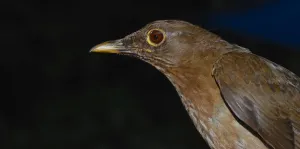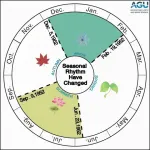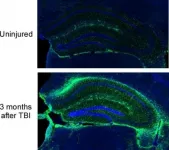Tracing malaria's ecology using blood samples from birds
2021-03-08
(Press-News.org) Malaria is the deadliest pathogen in human history. Nearly half the people on Earth are at risk of contracting the disease from the parasites that cause it. But humans aren't the only ones who can get these parasites--different forms are found in other animals, including birds. By studying the DNA of those strains, scientists can get a better picture of how malarial parasites live, which may give clues on how to stop the disease. In a new paper in PNAS, researchers analyzed blood samples of more than 1,000 species of birds from the Andes looking for malaria; they found that the strains of malaria present in a local area don't always neatly align with the types of birds living there.
"Traditionally, we thought that there's kind of a one-to-one relationship between hosts and parasites, that the evolutionary relationship between the parasites will mirror the evolutionary relationships of the host," says Heather Skeen, a PhD student at the University of Chicago and the Field Museum and one of the study's co-authors. "And what we found is that with birds and malaria, this is largely not true."
"This study was an opportunity to ask the question, 'What does a community of malarial parasites actually look like?'" says John Bates, curator of birds at the Field Museum and a co-author of the paper, which was led by Cornell University's Sabrina McNew and University of New Mexico's Christopher Witt. "It involved changing the way we do fieldwork to collect the relevant data. This research is an attempt to figure out how the ecological and evolutionary relationships of parasites compare to those of bird communities. We found that it's not simple."
He's right, it's not simple, but here's the background: malaria is a single-celled organism that lives as a parasite inside multiple host organisms during its life cycle, including the blood of birds and mammals and the guts of insects like mosquitoes. When humans are infected with malaria, it can kill us, but other animals, including most birds, often survive malaria infection. . And while humans can't catch bird malaria, getting a better understanding of malaria in birds might help us treat or prevent human malaria in the future.
To learn about malaria in birds, the researchers collected blood samples from thousands of birds in different parts of the Andes Mountains in Peru. These blood samples were then transported back to the Field Museum in Chicago and genetically sequenced at the museum's Pritzker DNA Laboratory.
The researchers then compared the DNA from the different birds as well as the different malaria parasites present in their blood. "There are hypothesized to be as many malarial strains as species of birds--about 10,000," explains Skeen.
To better understand how the ecological and evolutionary relationships of birds and their malaria pathogens, the team sampled 18 different biological communities in the Peruvian Andes, and when they analyzed the DNA of the birds and malaria present, they found around 1,350 bird species but only about 400 strains of malaria. They demonstrate that the kinds of birds in a community were good predictors for the strains of malaria in a community, but not vice versa--those same malaria strains might turn up in a different community of birds.
Instead, the researchers learned that the weather in different areas made a bigger difference to the strains of malaria present than the kinds of birds in the community. "Microclimate, or the climate in very specific habitats, appears to be the main driver of pathogen prevalence in communities," says Skeen. "Rainfall is one of the most significant predictors of community turnover, and I think that's because the insects that spread these parasites are more affected by variations in precipitation than birds are." For instance, extra rain might create stagnant puddles that mosquitoes lay their eggs in, and these mosquitoes help spread malaria throughout a community of birds.
The researchers, who along with Skeen, Bates, McNew, and Witt included Shannon Hackett and Shane DuBay from the Field Museum, analyzed the community patterns they found and mapped the biodiversity of both the birds and the parasites. These analyses could help scientists attempting to protect areas of extreme biodiversity within the Andes and give biologists a better understanding of how malaria strains evolve and change.
"It's a whole other research area for multiple people to potentially work on. There's a lot to do, there are literally people that have spent their graduate career pulling out salivary glands from mosquitoes and squashing them on the microscope slides in order to get access to the malaria in the salivary glands of mosquitoes," says Bates. "It highlights how far we've come and how far we have to go."
INFORMATION:
[Attachments] See images for this press release:

ELSE PRESS RELEASES FROM THIS DATE:
2021-03-08
(Boston)--Despite the positive advances that anti-human immunodeficiency virus (HIV) therapy, commonly called anti-retroviral therapy (ART) or highly active antiretroviral therapy (HAART), has had on the life expectancy of HIV-positive people, finding a cure for HIV or acquired immunodeficiency syndrome (AIDS) has remained elusive.
"One of the major challenges in curing HIV is that there is a persistent latent reservoir of virus that is not targeted by current antiretroviral treatments and is hidden from immune cells. When treatment is interrupted, this reservoir of the virus allows the HIV ...
2021-03-08
Here is a link to a free Altmetric Report on this Research Output
Aging-US published "Hyperbaric oxygen therapy increases telomere length and decreases immunosenescence in isolated blood cells: a prospective trial" which reported that the aim of the current study was to evaluate whether hyperbaric oxygen therapy (HBOT) affects telomere length (TL) and senescent cell concentrations in a normal, non-pathological, aging adult population.
Thirty-five healthy independently living adults, aged 64 and older, were enrolled to receive 60 daily HBOT exposures.
Whole blood samples were collected at baseline, at the 30th and 60th session, and 1-2 weeks following the last HBOT session.
Telomeres length of T helper, T cytotoxic, natural killer and ...
2021-03-08
CHAMPAIGN, Ill. -- Tiny fluorescent semiconductor dots, called quantum dots, are useful in a variety of health and electronic technologies but are made of toxic, expensive metals. Nontoxic and economic carbon-based dots are easy to produce, but they emit less light. A new study that uses ultrafast nanometric imaging found good and bad emitters among populations of carbon dots. This observation suggests that by selecting only super-emitters, carbon nanodots can be purified to replace toxic metal quantum dots in many applications, the researchers said.
The findings, published in the Proceedings of the National Academy of Sciences, ...
2021-03-08
About one billion people worldwide are at risk for schistosomiasis -- a debilitating disease caused by parasitic worms that live in fresh water and in intermediate snail hosts. A new study finds that the transmission risk for schistosomiasis peaks when water warms to 21.7 degrees centigrade, and that the most effective interventions should include snail removal measures implemented when the temperature is below that risk threshold.
The Proceedings of the National Academy of Sciences published the results, led by Emory University, the University of South Florida and the ...
2021-03-08
When it comes to microelectronics, there is one chemical element like no other: silicon, the workhorse of the transistor technology that drives our information society. The countless electronic devices we use in everyday life are a testament to how today very high volumes of silicon-based components can be produced at very low cost. It seems natural, then, to use silicon also in other areas where the properties of semiconductors -- as silicon is one -- are exploited technologically, and to explore ways to integrate different functionalities. Of particular interest in this ...
2021-03-08
Determining how rapidly the universe is expanding is key to understanding our cosmic fate, but with more precise data has come a conundrum: Estimates based on measurements within our local universe don't agree with extrapolations from the era shortly after the Big Bang 13.8 billion years ago.
A new estimate of the local expansion rate -- the Hubble constant, or H0 (H-naught) -- reinforces that discrepancy.
Using a relatively new and potentially more precise technique for measuring cosmic distances, which employs the average stellar brightness within giant elliptical galaxies as a rung on the distance ladder, astronomers calculate a rate -- 73.3 kilometers per second per megaparsec, give or take 2.5 km/sec/Mpc -- that lies in the middle of three ...
2021-03-08
Inflammation in the body has been linked to the intensity of tobacco smoking among people with HIV, according to a team of University of Massachusetts Amherst researchers.
Krishna Poudel, associate professor of community health education in the School of Public Health and Health Sciences, and colleagues reported positive linear relationships between intensity, duration and pack-years of smoking and inflammation in HIV-positive people. They believe it to be the first, more thorough examination of specific smoking-related variables with the levels of inflammation in this group, while also taking into account highly active antiretroviral therapy (HAART) and other important factors.
The study's findings ...
2021-03-08
WASHINGTON--Without efforts to mitigate climate change, summers spanning nearly six months may become the new normal by 2100 in the Northern Hemisphere, according to a new study. The change would likely have far-reaching impacts on agriculture, human health and the environment, according to the study authors.
In the 1950s in the Northern Hemisphere, the four seasons arrived in a predictable and fairly even pattern. But climate change is now driving dramatic and irregular changes to the length and start dates of the seasons, which may become more extreme in the future under a business-as-usual climate scenario.
"Summers are getting longer and hotter while winters shorter and warmer ...
2021-03-08
Nursing homes with the largest proportions of non-White residents experience 3.3 times more COVID-19 deaths than do nursing homes with the largest proportions of White residents, according to a new study from the University of Chicago. The paper, published in JAMA Network Open, suggests that these differences are likely due to nursing home size and the level of coronavirus spread in the local community, reinforcing the inseparability of long-term care facilities from society at large when it comes to bringing the COVID-19 pandemic to heel.
Since the start of the ...
2021-03-08
Traumatic brain injury (TBI) is a major cause of disability and a risk factor for early-onset dementia. The injury is characterized by a physical insult followed acutely by complement driven neuroinflammation. Complement, a part of the innate immune system that functions both in the brain and throughout the body, enhances the body's ability to fight pathogens, promote inflammation and clear damaged cells. Complement plays a role in the brain, regardless of infection or injury, as it influences brain development and synapse formation. In TBI, complement- induced inflammation partially determines the outcome in the weeks immediately following injury. However, more research is needed to define a role for the complement system in neurodegeneration ...
LAST 30 PRESS RELEASES:
[Press-News.org] Tracing malaria's ecology using blood samples from birds







